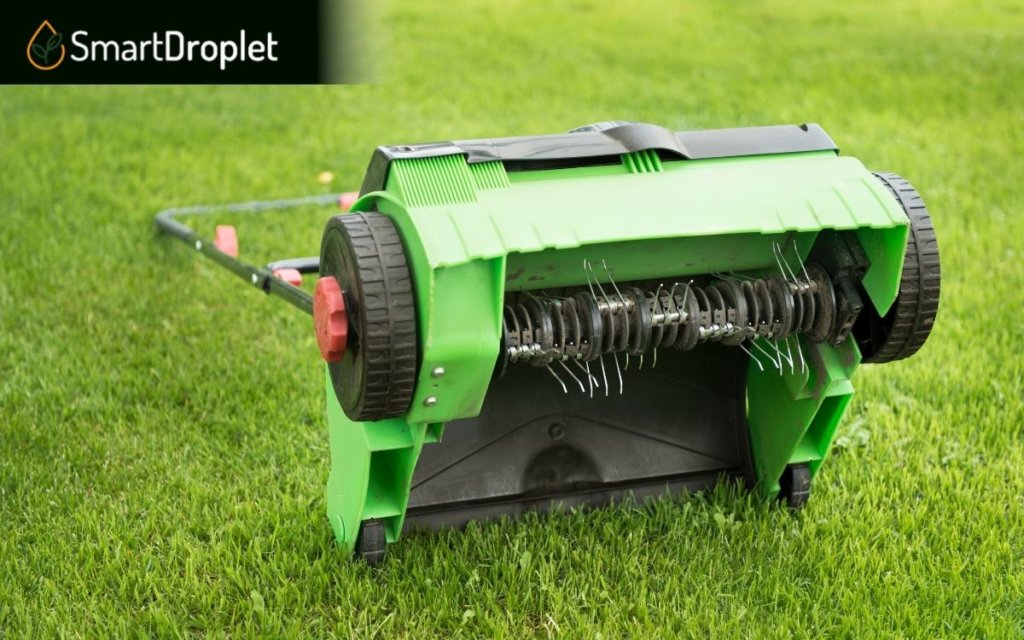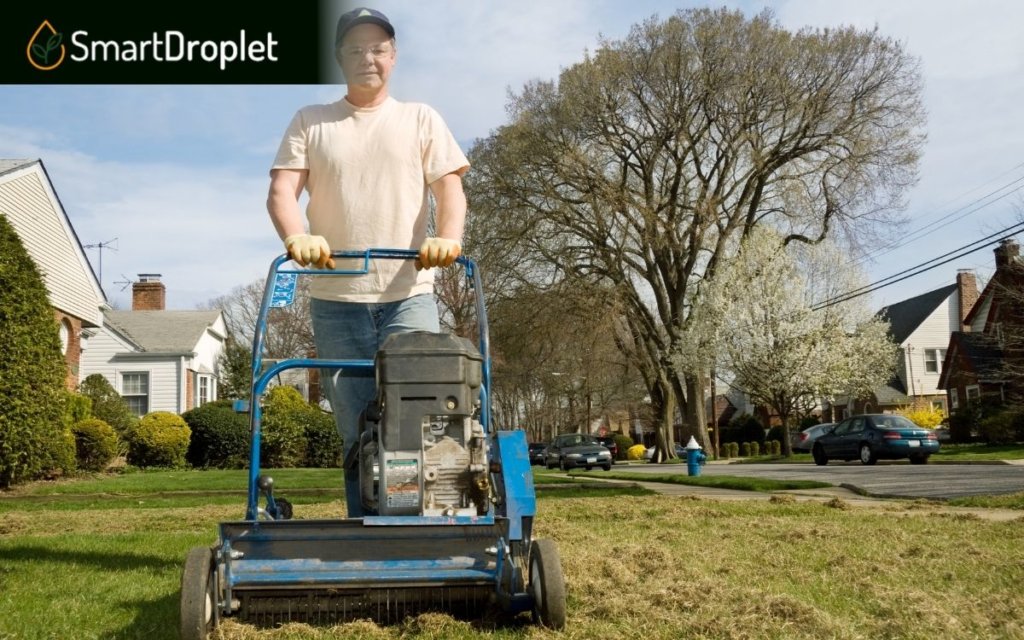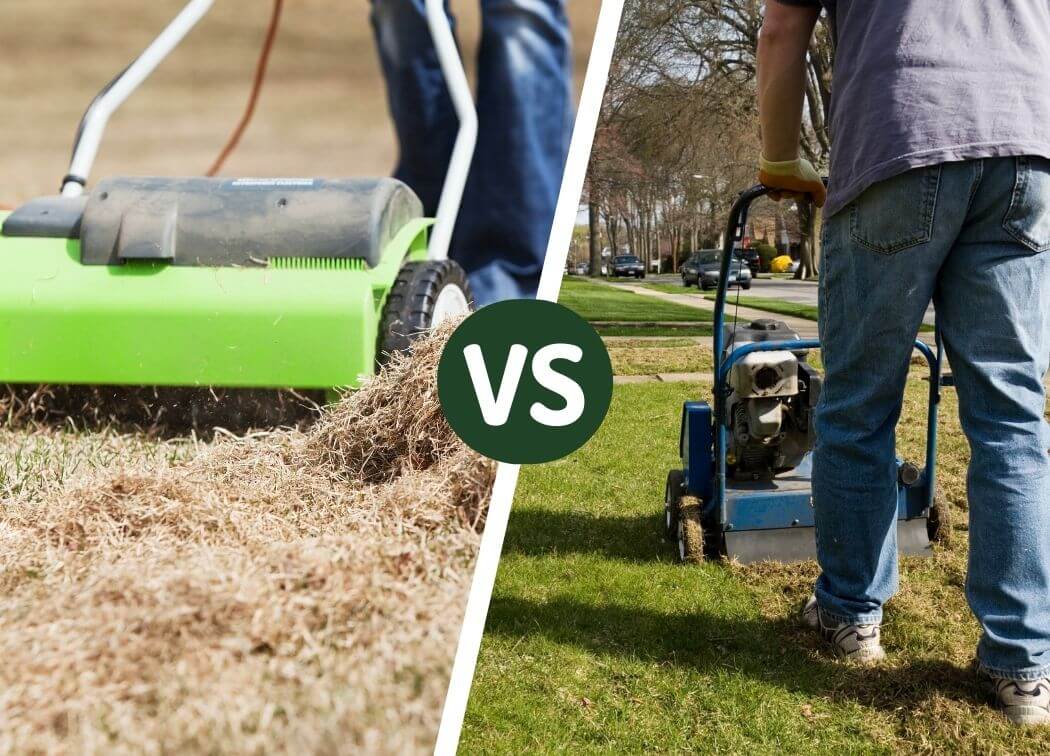Both the power rake and the dethatcher are thatch removal tools. Both tools are mechanically operated, but they can also be gas or even electrical powered! However, when comparing the two, you might ponder the question, “Which among these two tools is better than the other for thatch removal?”
The main difference between a power rake and a dethatcher is that a power rake is MORE aggressive at removing dead grass debris buildup than a dethatcher, thus it can remove thatch buildup up to 4x better. If your thatch buildup is only less than half an inch, dethatchers will do a good job. If more, it should be power raked.
A power rake uses a dethatching blade with rotating flails that dig deep into a thick layer. It should be used when thick layers of brown patches and debris are observed or you know that you haven’t dethatched your lawn for a long time.
On the other hand, a dethatcher is used for getting rid of a thin layer of decomposing organic matter. These are usually used for surface-level thatch layers that you can take care of with a light process.
As you read the article, you will come to learn the functions and operations of a power rake vs. a dethatcher and learn which one works BETTER than the other. Let’s continue!
Quick Summary: Power Rake vs. Dethatcher Differences
The main difference between power rakes and dethatchers is their aggressiveness in removing thatch.
- Power Rakes: Use a more aggressive process to make removing thick layers fast and easy.
- Dethatchers: They are less aggressive and used for residential or smaller lawns. Dethatchers are more beginner-friendly.
But we’re only scratching the surface of the differences. We’ll discuss more of these tools in the following sections.
What’s Thatch?
Thatch buildup is composed of both live and dead organic matter.
These include dead grass, dried grass leaves, grass roots, cut grass clippings, stems, and other organisms accumulated over time.
A small layer of thatch is beneficial to insulate the lawn and act as a protective barrier. However, too much thatch makes it difficult for the grass to breathe.
Excess thatch also prevents new grass seed from germinating.
Power Rake vs. Dethatcher + Differences
Let’s go in-depth to the differences between power raking and dethatching.
Power Rakes
Power raking removes a visible thick layer of thatch and dead grass debris. As discussed, it uses a more aggressive process to make the heavy-duty job more efficient.
You need to power rake when you’ve left the matter buildup for too long, and it has now become a thatch problem affecting your soil surface and grass.
A power rake is a mechanical tool that uses a dethatching blade with rotating flails that dig deep into a thick layer. The main goal is to expose the soil surface.

In terms of overall appearance, it’s easy to spot a power rake. It’s a heavy-duty machine that may even look a little intimidating to some.
How to Use a Power Rake
Here’s a step-by-step process on how to power rake better.
- Determine how much thatch layer is built up. If it’s more than half-inch, it’s time to resort to power raking.
- Test your power rake first to see the output. Adjust the power as needed.
- Lower the notch gradually to avoid affecting live and healthy grass.
- Run the power rake on the entire lawn consistently.
- Clean the rest of the debris using a lawn rake or leaf rake.
- Run the power rake for the second time. This time, do it in the opposite direction for an even result.
- Finish by cleaning the rest of the debris again using a lawn or leaf rake.
When Are the Best Times to Power Rake?
It’s also best to do it seasonally as part of your regular lawn maintenance.
- Warm-season grass: Late spring to early summer
- Cool-season grasses: Early fall or early spring
But as long as you don’t see a thick layer of dead grass and debris, even during the seasons mentioned above, avoid power raking your lawn.
Dethatchers
Dethatching is for getting rid of a thin layer of decomposing organic matter. These are usually used for surface-level thatch layers that you can take care of with a light process.
Unlike a power rake, it only has a dethatching blade without the rotating flails. Instead, it has rotating spring tines meant for removing the thatch layer.

Dethatchers look similar to a push lawnmower. They don’t look intimidating, and true enough, beginners find it easy to navigate the tool even without much experience.
There are different types of dethatchers: manual, tow-behind dethatchers, and powered dethatchers.
- Manual: almost like a regular rake, but with thicker metal spring tines, and some come with wheels on the side.
- Tow-Behind Dethatchers: as the name goes, they’re towed behind a lawn mower. It’s like a 2-in-1 device or the same machine.
- Powered: spring tines are driven by a machine instead of manual control.
The Best Times to Use a Dethatcher
The recommended times to power rake your lawn is as follows:
- In early spring or fall for cool-season grasses. Dethatching can be done more often than power raking.
- In late spring or early summer for warm-season grass.
- Before you start applying spring fertilizer, it helps with better fertilizer absorption afterward.
It’s best to dethatch on dormant turf to avoid damaging growing and healthy grass. We suggest understanding the lawn well and knowing the grass growth cycle first.
- Robust 10 Amp motor
- 14-inch dethatching path gets your work done faster
- Stainless steel tines stay sharp longer for reliable performance
- Ergonomic, padded grip and adjustable handle for user comfort
In terms of frequency, you can stick to a regular schedule of once a year. But when you notice more thatch than usual, you can start dethatching even before the program.
To be sure, you can extract a thatch sample (a portion of the soil) and observe. If it is spongy and dead organic matter, start dethatching.
What are the Causes of Thatch Buildup?
Other than committing no action to the thatch, there are other ways thatch can build up, and we do not want that!
While thatch is normal, specific practices and causes speed up the growth. Knowing the probable causes will help you control the situation.
Improper Lawn Mowing
Pick up the grass clippings after using a lawn mower. It’s okay to leave some intentionally, but make it a habit not to let it pile up.
Wrong Lawn Watering Techniques
Some may think that watering your lawn is as easy as sprinkling water everywhere and calling it a day. Without the proper techniques, debris can pile up quickly.
Here’s a video tutorial from The Lawn Whisperer on Youtube.
Poor Lawn Aeration and Drainage
Thatch can quickly form if the aeration and drainage are inadequate. Ensure that your soil has proper ventilation so your lawn can “breathe” better.
When the soil is too compact, water won’t drain properly, and it won’t absorb nutrients and fertilizers well.
Understand that while this is not a direct cause of thatch, it kills the lawn, and those dead leaves make up the thatch layer.
Overusing Chemical Pesticides or Synthetic Fertilizers on Lawn
One major cause of thatch is too much chemical or acid. Thatch buildup is a sign that you are using too many pesticides or synthetic fertilizers.
It can be tricky if you’re dealing with pests and thatch simultaneously.
It would be best if you had the pesticide to get rid of the problems, but then it’s contributing to thatch. In these cases, we suggest going for organic products.
The good news is that there are now many options in the market.
Fungal Infections and Pests
Since thatch is composed of dead grass, you may want to check why your grass roots are dying quickly.
There may be a case of fungal infections or grubs and pests eating your lawn grass.
Maintain your lawn quickly, and do NOT waste time before the infections spread throughout the territory!
Power Rake vs. Dethatcher – What are the Pros and Cons?
Let’s further differentiate the power rake vs. dethatcher by discussing their advantages and drawbacks.
It is extremely beneficial to know the capabilities of both products to fully utilize either, depending on what you’ll buy soon! It also provides a bigger grasp on the market!
Power Rake Pros
Here are the best features the power rake offers its customers! These benefits convince many customers to use this over the dethatcher.
- Efficient for large and commercial lawns
- Best for heavy-duty lawn work
- Suitable for lawn makeovers or when starting from scratch
- If the user is knowledgeable on usage, You can also use it to perform the purpose of the dethatcher (can replace a dethatcher)
Power Rake Cons
Here are the biggest drawbacks the power rake has! These could be the reasons why not everyone buys the power rake.
- Too aggressive for lawn; causes stress.
- Beginners will find it hard to use a power rake; call a professional to avoid lawn damage.
- Expensive tool
Dethatcher Pros
Here are the biggest advantages of using a dethatcher! You may be wondering why people buy a dethatcher, and these are why:
- Beginner-friendly
- Not too aggressive on your lawn
- More affordable than a power rake
- More portable and easy storage
Dethatcher Cons
Here are the biggest disadvantages of the dethatcher! There could be deal-breakers in the dethatcher that cause customers to buy the power rake instead.
- Cannot do heavy-duty jobs
- Since it’s not as aggressive, regular maintenance is needed
- Cannot replace a power rake
Power Rake vs. Dethatcher Recap [TL;DR]
Both power rakes and dethatchers are used to dislodge debris buildup on the soil. But they differ in terms of usage and performance.
Power Rake
Here is a quick summary of the power rake and its functions!
- More aggressive process
- Used for large lawns or thick debris layers (more than 1/2 inch)
- More heavy-duty
- Better used for uprooting a lawn
- Can damage the lawn and healthy grassroots
- More expensive
- Not meant for beginners
- To be used during dormant seasons
- Power raking the lawn before fertilization or heavy watering is helpful.
Dethatcher
Here is a quick recap of the dethatcher and how it works!
- Lighter process
- Used for residential and small lawns
- Used when the thatch layer is less (1/2 inch or less)
- Not heavy-duty
- Suitable for regular lawn maintenance and care
- Kinder to the lawn
- Affordable
- Beginners can use it well
Causes of Thatch
Here’s a quick review of what causes thatch on your lawn.
- Improper lawn mowing
- Wrong watering techniques
- Poor aeration and drainage
- Overusing chemicals and synthetic fertilizers
- Fungal infections and pests
Conclusion
A lot of people confuse power rakes and dethatchers. You may think that using them interchangeably is a minor matter since it arrives at the same purpose.
While it’s true for professionals, beginners may find themselves harming the lawn more than caring for it.
It doesn’t hurt to know how these products operate. Whether good or bad, you will always grasp a better picture of how the market and the products differentiate!
Learning the difference makes a difference, and we hope this article helped!
Frequently Asked Questions (FAQs)
Do you still need some information regarding the topic?
Here are the FAQs! Hopefully, your concerns and issues are answered in this article section.
Why Power Rake or Dethatch Your Lawn?
Thatch is one of the inevitable factors when maintaining a grass lawn. It’s natural to have excess grass material.
You don’t need to worry or remove thatch every time you see small buildups.
A thin layer of thatch is beneficial as it absorbs excess moisture and serves as a healthy barrier for fluctuating temperatures and weather conditions.
However, you need to remove thatch when it starts to pile up and become too thick.
When this happens, your lawn and healthy grass won’t get the proper nutrients and fertilizer well, leading to damaged roots and poor lawn growth.
Most homeowners ignore thatch until it gets uncontrollably thick or other problems arise.
While a power rake can come to your rescue, don’t wait until the situation becomes severe.
Is Power Raking Bad for My Lawn?
Using a power rake has its benefits. As discussed, it makes the heavy-duty process of removing thick thatch layers efficient.
You can use a power rake to do the job of a dethatcher, but a dethatcher can’t live up to the performance of a power rake. That in itself makes the tool essential for lawn caretakers.
Avoid power raking your lawn during growing seasons, as it will kill off those budding leaves. It’s best to do it during dormant seasons.
Don’t get us wrong, though.Again, power raking has undeniable benefits.
For instance, when you power rake before a fertilization program, it can speed up the absorption by a notch.



